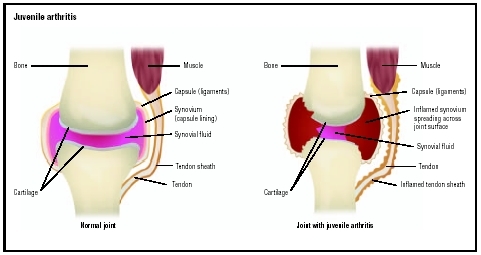We often associate arthritis with old people. While it is true that seniors are the most common patients of this painful joint disorder, the fact is even children can be afflicted with this disease. In the United States alone, some 300,000 children under 16 years of age are suffering from juvenile arthritis. Although most patients bear with the pain and discomfort for some weeks or months, there are instances when juvenile arthritis lasts a lifetime.
The most common form of juvenile arthritis is juvenile idiopathic arthritis (JIA) which affects more than 50,000 kids in the US.
Causes
There is no clear cause of arthritis among children, although most studies suggest that it is an autoimmune disease. As such, the white blood cells of the body cannot discern the dissimilarity between the healthy cells and germs like viruses and bacteria. Because of this lapse, the immune system instead releases chemicals that damage the healthy tissues of the body, causing pain and inflammation that characterize juvenile arthritis.
Symptoms
 Children who suffer from arthritis will experience swelling of the joints, particularly in the knee. They may not complain much about joint pain, but there is a noticeable limp especially after waking up. The limp can be attributed to the pain felt in the joints, which fortunately is not as intense as
Children who suffer from arthritis will experience swelling of the joints, particularly in the knee. They may not complain much about joint pain, but there is a noticeable limp especially after waking up. The limp can be attributed to the pain felt in the joints, which fortunately is not as intense as
those experienced by adults. There is also stiffness in the joints and this is manifested by the child appearing clumsier after naps or in the morning. Juvenile arthritis can affect one or more joints of the body. In rarer cases, it can affect the entire body of a child. When this happens, other symptoms like rashes, swollen lymph nodes and fever may be experienced. And like other types of arthritis, this form of arthritis afflicting children can have its symptoms worsen from time to time, or disappear all of a sudden.
Treatment
Joint pain and inflammation can be reduced by the use of prescription drugs like Enbrel (etanercept). This drug is injected into the patient suffering from juvenile arthritis, and other musculoskeletal problems like psoriatic arthritis, ankylosing spondylitis and rheumatoid arthritis. It works by blocking the TNF alpha, a protein produced in the body when there is an inflammation. TNF alpha production is the body’s reaction to an injury and promotes inflammation and other associated symptoms like fever and tenderness of the joints. It is safe for use in children as young as two years old.
Enbrel may cause side effects, especially if it is administered for the first time to a patient. The more commonly reported side effects of this drug are chills, fever, cough, sneezing, and sore throat. Other children who used this before also experienced rapid heartbeat, painful urination, itching of the skin, difficulty in breathing and depression. Aside from Enbreal, doctors usually ask their patients with juvenile arthritis to undergo an appropriate physical therapy program to manage the symptoms of the condition. In this program, the child may have to do range-of-motion exercises to bring back the flexibility of stiff and sore joints.
Share This